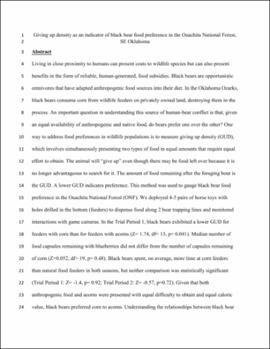| dc.description.abstract | Living in close proximity to humans can present costs to wildlife species but can also present benefits in the form of reliable, human-generated, food subsidies. Black bears are opportunistic omnivores that have adapted anthropogenic food sources into their diet. In the Oklahoma Ozarks, black bears consume corn from wildlife feeders on privately owned land, destroying them in the process. An important question in understanding this source of human-bear conflict is that, given an equal availability of anthropogenic and native food, do bears prefer one over the other? One way to address food preferences in wildlife populations is to measure giving up density (GUD), which involves simultaneously presenting two types of food in equal amounts that require equal effort to obtain. The animal will "give up" even though there may be food left over because it is no longer advantageous to search for it. The amount of food remaining after the foraging bout is the GUD. A lower GUD indicates preference. This method was used to gauge black bear food preference in the Ouachita National Forest (ONF). We deployed 4-5 pairs of horse toys with holes drilled in the bottom (feeders) to dispense food along 2 bear trapping lines and monitored interactions with game cameras. In the Trial Period 1, black bears exhibited a lower GUD for feeders with corn than for feeders with acorns (Z= 1.74, df= 13, p= 0.041). Median number of food capsules remaining with blueberries did not differ from the number of capsules remaining of corn (Z=0.052, df= 19, p= 0.48). Black bears spent, on average, more time at corn feeders than natural food feeders in both seasons, but neither comparison was statistically significant (Trial Period 1: Z= -1.4, p= 0.92; Trial Period 2: Z= -0.57, p=0.72). Given that both anthropogenic food and acorns were presented with equal difficulty to obtain and equal caloric value, black bears preferred corn to acorns. Understanding the relationships between black bear behavior and both anthropogenic and natural foods will help design effective policy and outreach programs in mitigating human-black bear conflict. | |
